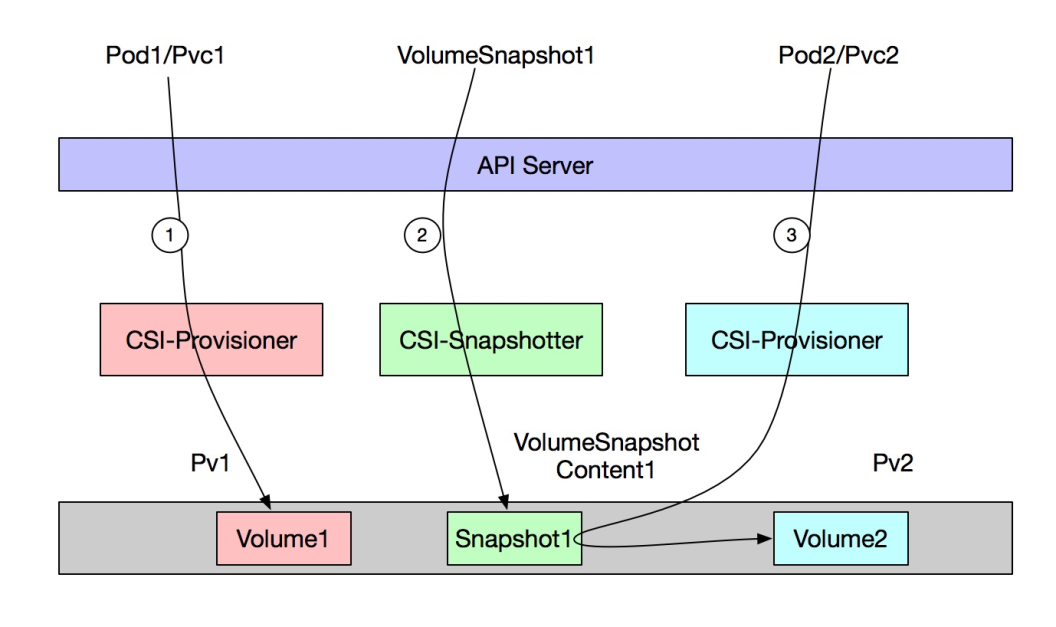By Junbao
Disk-based data volumes are often used for data storage when stateful services are deployed to Alibaba Cloud Kubernetes (ACK) clusters. Despite the disk data backup (snapshotting) and recovery mechanisms in place, it remains a challenge for cloud-native storage services to integrate the underlying capabilities and Kubernetes services, and provision these services to apps in a flexible manner. Kubernetes enables backup and recovery capabilities by using the following features:
The VolumeSnapshot feature remains in the Alpha phase in Kubernetes 1.16, and therefore it is not deployed to ACK clusters by default. Instead, it requires manual installation of the plug-in to use this feature.
Kubernetes defines the following three resource types in Custom Resource Definition (CRD) in order to implement snapshot functions:
Let's take a look at the key rules for binding snapshot resources.
1) While using a snapshot object, first bind the VolumeSnapshot object with the VolumeSnapshotContent object, which is similar to binding a PV with a PVC.
2) If no static VolumeSnapshotContent object is available to bind with the VolumeSnapshot object, Kubernetes creates a dynamic VolumeSnapshotContent object for this purpose.
3) VolumeSnapshotContent and VolumeSnapshot objects are bound in a one-to-one manner.
If you delete a VolumeSnapshotContent object, its backend snapshot will also be deleted.
The following snippet shows a VolumeSnapshotClass definition template.
apiVersion: snapshot.storage.k8s.io/v1alpha1
kind: VolumeSnapshotClass
metadata:
name: default-snapclass
snapshotter: disk-snapshot
parameters:
forceDelete: "false"The key terms in the above snippet are given below:
The following snippet shows a VolumeSnapshot definition template.
apiVersion: snapshot.storage.k8s.io/v1alpha1
kind: VolumeSnapshot
metadata:
name: snapshot-test
spec:
snapshotClassName: default-snapclass
source:
name: pvc-disk
kind: PersistentVolumeClaimThe key terms in the above snippet are listed below:
Creating VolumeSnapshot resources helps to create a snapshot instance for a disk (associated through the PVC).
Snapshot-based creation of disks is a basic function provided by Alibaba Cloud disks. The Alibaba Cloud Container Service for Kubernetes allows specifying the snapshot for a data source in the PVC to enable snapshot-based dynamic creation of disks.
kind: PersistentVolumeClaim
apiVersion: v1
metadata:
name: disk-snapshot
spec:
accessModes:
- ReadWriteOnce
storageClassName: alicloud-disk-ssd
dataSource:
name: snapshot-test
kind: VolumeSnapshot
apiGroup: snapshot.storage.k8s.io
resources:
requests:
storage: 20GiThe key terms in the above snippet are listed below:
Before deploying CSI snapshotter, create an ACK 1.16 cluster and enable the CSI plug-in while creating the cluster. For more information about how to create a cluster, see Create a Kubernetes Cluster.
Download the CSI snapshotter template here.
Deploy the plug-in using the command below:
$ kubectl apply -f csi-snapshotter.yamlAfter the deployment, the CSI plug-in appears as follows in the cluster:
# kubectl get pod -nkube-system |grep csi
csi-plugin-25xhh 9/9 Running 0 28h
csi-plugin-5xjqh 9/9 Running 0 28h
csi-plugin-9p4kd 9/9 Running 0 28h
csi-plugin-tmlmg 9/9 Running 0 28h
csi-plugin-tw57q 9/9 Running 0 28h
csi-provisioner-577d66cbb7-zks24 8/8 Running 0 161m
csi-provisioner-577d66cbb7-kja32 8/8 Running 0 161m
csi-snapshotter-859bdf8888-mq4dk 2/2 Running 0 161mThe following figure shows the three-steps process to use the plug-in.

The preceding steps fulfill the following purposes:
Download the VolumeSnapshotClass template.
$ kubectl apply -f volumesnapshotcalss.yaml
apiVersion: snapshot.storage.k8s.io/v1alpha1
kind: VolumeSnapshotClass
metadata:
name: default-snapclass
snapshotter: diskplugin.csi.alibabacloud.com
parameters:
forceDelete: "true"
# kubectl get VolumeSnapshotClass
NAME AGE
default-snapclass 4h40mStep 1) Create an original app and write data to it
$ kubectl apply -f sts.yaml
apiVersion: apps/v1
kind: StatefulSet
metadata:
name: web
spec:
selector:
matchLabels:
app: nginx
serviceName: "nginx"
replicas: 1
template:
metadata:
labels:
app: nginx
spec:
containers:
- name: nginx
image: nginx
volumeMounts:
- name: disk-ssd
mountPath: /data
volumeClaimTemplates:
- metadata:
name: disk-ssd
spec:
accessModes: [ "ReadWriteOnce" ]
storageClassName: "alicloud-disk-snap"
resources:
requests:
storage: 20Gi# kubectl exec -ti web-0 touch /data/test
# kubectl exec -ti web-0 ls /data
lost+found testStep 2) Create a VolumeSnapshot object
$ kubectl apply -f snapshot.yaml
apiVersion: snapshot.storage.k8s.io/v1alpha1
kind: VolumeSnapshot
metadata:
name: new-snapshot-test
spec:
snapshotClassName: default-snapclass
source:
name: disk-ssd-web-0
kind: PersistentVolumeClaimCheck the cluster status to ensure that the VolumeSnapshot and VolumeSnapshotContent objects have been successfully created. Additionally, log on to the ECS console to check that the snapshot instance has been created.
# kubectl get VolumeSnapshot
NAME AGE
new-snapshot-test 173m
# kubectl get VolumeSnapshotContent
NAME AGE
snapcontent-b9bcccde-9ea4-41f0-967d-3647b8a5cc29 173mStep 3) Restore the data
$ kubectl apply -f sts-snapshot.yaml
apiVersion: v1
kind: PersistentVolumeClaim
metadata:
name: disk-snapshot-restore
spec:
accessModes:
- ReadWriteOnce
storageClassName: alicloud-disk-snap
resources:
requests:
storage: 20Gi
dataSource:
name: new-snapshot-test
kind: VolumeSnapshot
apiGroup: snapshot.storage.k8s.io
---
apiVersion: apps/v1beta2
kind: StatefulSet
metadata:
name: web-restore
spec:
selector:
matchLabels:
app: nginx
serviceName: "nginx"
template:
metadata:
labels:
app: nginx
spec:
containers:
- name: nginx
image: nginx
ports:
- containerPort: 80
name: web
volumeMounts:
- name: pvc-disk
mountPath: /data
volumes:
- name: pvc-disk
persistentVolumeClaim:
claimName: disk-snapshot-restoreSpecify dataSource as the VolumeSnapshot type in the PVC definition, and select the VolumeSnapshot object named "new-snapshot-test" created in Step 2.
Check the pod data to verify whether the recovery was successful using the code below.
# kubectl exec -ti web-restore-0 ls /data
lost+found testNote that the data has been restored.
This solution only depicts a scenario where a snapshot is created to implement data recovery. The solution to the timed-creation of snapshots will be provided later.
Knative on Alibaba Cloud: The Ultimate Serverless Experience
Alluxio Deep Learning Practices - 1: Running PyTorch Framework on HDFS

166 posts | 30 followers
FollowAlibaba Container Service - November 7, 2024
Alibaba Cloud Storage - February 27, 2020
Alibaba Container Service - July 16, 2019
Alibaba Container Service - April 17, 2024
Alibaba Container Service - November 13, 2019
5544031433091282 - October 8, 2023

166 posts | 30 followers
Follow Backup and Archive Solution
Backup and Archive Solution
Alibaba Cloud provides products and services to help you properly plan and execute data backup, massive data archiving, and storage-level disaster recovery.
Learn More Cloud Backup
Cloud Backup
Cloud Backup is an easy-to-use and cost-effective online data management service.
Learn More Container Service for Kubernetes
Container Service for Kubernetes
Alibaba Cloud Container Service for Kubernetes is a fully managed cloud container management service that supports native Kubernetes and integrates with other Alibaba Cloud products.
Learn More Data Lake Storage Solution
Data Lake Storage Solution
Build a Data Lake with Alibaba Cloud Object Storage Service (OSS) with 99.9999999999% (12 9s) availability, 99.995% SLA, and high scalability
Learn MoreMore Posts by Alibaba Container Service